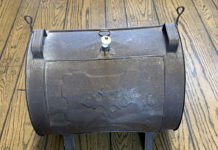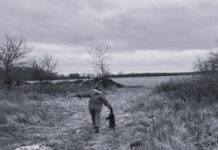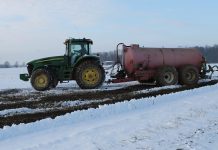As the end of April draws near, we welcome in May. The first Saturday in May has always been a favorite of mine.
Ever since I was a child, I knew that was the Kentucky Derby weekend. The migration of thousands to Louisville, Kentucky, to watch those magnificent horses race is something special to me. Another fond childhood memory I have is the migration of the beautiful monarch butterfly.
Great decline
But unlike the Kentucky Derby, the monarch butterfly has not thrived in my lifetime. Sadly, it is now in great decline and its main . . . well, only sourcing of food; milkweed is just about as scarce as the butterfly itself. My hope is that it’s not too late and we will once again be able to see these beautiful winged creatures flying around in abundance someday, just like we can go to the track and watch the horses’ race on any special weekend.
So, we are in our own race with Mother Nature to win back monarch butterflies and other important pollinators.
Pollinator problems
It is estimated that the population of monarchs has diminished by 90 percent over the past twenty years. That would be like losing every living person in the U.S. except those in Florida and Ohio. Imagine that loss in just 20 years!
The loss is sending environmental red flags up and efforts should be made to help this favorite butterfly. The main reasons for the monarch decline are forestry/habitat loss — where the monarchs overwinter in Mexico, and a major decline in milkweeds in much of North America combined with the used of herbicides.
The director of the organization Monarch Watch, Chip Taylor states “… Development is consuming 6,000 acres a day, a loss of 2.2 million acres per year. Further, the overuse of herbicides along roadsides and elsewhere is turning diverse areas that support monarchs, pollinators, and other wildlife into grass-filled landscapes that support few species. The adoption of genetically modified soybeans and corn have further reduced monarch habitat. If these trends continue, monarchs are certain to decline, threatening the very existence of their magnificent migration.”
The solutions
We know what the problems are, and for the most part have the solutions. No, we cannot control the weather, but we can make an effort and try to help these iconic insects so that they will once again flourish, and we can enjoy their beauty.
Understanding why
“Educating the mind without educating the heart is no education at all” — Aristotle.
In order for us to help the butterflies, bees, bats, amphibians and so many important species of threatened wildlife, we need to educate and “convince” those that may need some persuasion why they should do so. First, one must understand the life cycle of the monarch butterfly and its metamorphosis. The four parts of the life cycle are the egg, caterpillar, pupa and adult.
The most vital component of the monarch’s life cycle is the host plant — which are milkweeds. Butterflies lay eggs on the milkweed plants, and soon the caterpillars hatch and begin eating the milkweed foliage. The caterpillar will go through its pupa stage as it forms a beautiful chrysalis, and will later force its way out as an adult monarch butterfly.
Monarch migration
There can be two-to-four different broods in Ohio. The last brood then will make the incredible fall migration traveling nearly 2,000 miles one way to the wintering grounds in Mexico. Monarchs depend on milkweeds as host plants. Yes, the butterflies also need nectar plants for food, and they help pollinate those, but monarch larvae feed exclusively on milkweeds.
Importance of pollinators
Why should someone care about butterflies, bees and other insects? For starters, the abundance and diversity of insects and invertebrates are the building blocks for wildlife. They are a food source for other animals (birds & mammals). But most of all, they provide an ecosystem service. That service is pollination. In agriculture, 87 percent of the world’s 124 most commonly cultivated crops are animal pollinated, and insect-pollinated forage plants such as alfalfa and clover provide feed for livestock.
Plant pollination by insects is essential to human health, global food webs and protection of biodiversity.
Balancing life
We share this planet with vast biodiversity and it’s our duty to keep it in balance. Join the race. Everyone can do their part. This effort is not geared toward one certain type of person. Farmers can create some field buffers, plant native plants (especially milkweed) and limit the use of chemical spray near those edges.
Homeowners can create a small backyard habitat with milkweed to connect to nature. Schools can plant milkweed and educate children about the amazing monarch migration and habitat improvements. State and county governments can get involved (as due Iowa & Minnesota) about managing roadsides for bees and butterflies by planting native wildflowers, grasses, avoiding pesticides, and limiting mowing.
Native plants are great also because they can survive winter cold and summer heat. The deep roots of native plants also help hold soil and control erosion and withstand droughts. The overall benefits from monarchs to wildlife to water quality can be improved if we bring back the milkweeds and native plants.
It’s not too late — get involved; join the race!













Mathematically it’s not possible for monarch butterfly enthusiasts to increase the wild monarch population. Why? Because approximately 3 billion milkweed plants still grow in the wild and support the existing population of 100 million fall migrant monarch butterflies. So that means roughly 30 plants produce 1 fall migrant butterfly. So even if enthusiasts planted 100,000 more milkweeds during the next 5 years, only about 3,333 more fall migrant butterflies would be produced – not even 1/100th of one percent more than already exist! It is also untrue that milkweed has been wiped out from agricultural landscapes. The truth is milkweed still grows in hundreds of thousands of miles worth of rural gravel farm road ditches in the upper Midwest like these: http://www.imagegainer.com/images/PaulCherubini/tagus.jpg http://www.imagegainer.com/images/PaulCherubini/milk.jpg
Your readers can get Free Milkweed Seeds. Just go to SaveOurMonarchs.org, and request the seeds.
They are shipped within two days after the request is received.
Thanks
Ward Johnson
SaveOurMonarchs.org
952-829-066